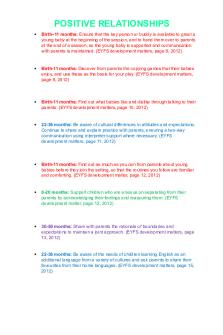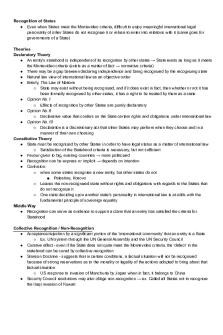Recognition of Same-Sex Relationships (Essay) PDF

| Title | Recognition of Same-Sex Relationships (Essay) |
|---|---|
| Author | Dylan Stibbard |
| Course | Legal Studies |
| Institution | Higher School Certificate (New South Wales) |
| Pages | 3 |
| File Size | 75.3 KB |
| File Type | |
| Total Downloads | 24 |
| Total Views | 139 |
Summary
Evaluation of recognition of same-sex relationships in Australia.
Includes De-facto relationships, Marriage Bill 2017, etc....
Description
Evaluate the legal & non-legal responses to the issues of same-sex relationship recognition. The issue surrounding same-sex relationship recognition has seen various legal and non-legal responses, having a moderate amount of effectiveness in responding to this issue. Over recent years, our society has shifted its views and opinions on same-sex relationships after previously being discriminatory, the laws have moved accordingly from responses in Australia. This can be seen through both legal and non-legal aspects such as law reform, and the work of NGOs and the media. Areas of legal reform include De Facto relationships and Marriage. Non-Governmental Organisations and the media have also responded to this issue by lobbying the government for change and writing articles on the issue. Laws in the area of De Facto relationships have had a limited amount of effectiveness in responding to the issue of same-sex relationship recognition. Since the 80s, De Facto relationships have become more widely recognised in Australia, seen through the De Facto Relationship Act 1984 (NSW) which provided a specific mechanism for property settlement when de facto couples split. However, this only catered to heterosexual couples and led to same-sex couples not being treated in the same manner. New South Wales was the first state to enact reforms to this area. In 1999, The Property (Relationships) Legislation Amendment Act 1999 (NSW) was enacted, which amended twenty pieces of legislation such as inheritance and accident compensation. Where a definition of de facto relationship in existing law failed to include same-sex couples, these definitions were amended or replaced so that the law would no longer apply differently to same-sex couples. Other examples of law reform include the Same-Sex Relationships (Equal Treatment in Commonwealth) Act 2008 which removed discrimination against same-sex couples from a raft of Commonwealth legislation, including veteran affairs, social security and income tax. These legal responses have had a moderate amount of effectiveness they were not very responsive to changed values. The law responded quite slowly to this issue within the Australian community and showcased how slow the law evolved to respond to changes in society, primarily the values and opinions that people shared around same-sex relationships which were drastically different to what historically were shared values, where discrimination was highly common among minority groups such as same-sex relationships. These reforms also lose effectiveness due to them not meeting society’s needs, primarily those in same-sex relationships. In order to benefit from these law reforms, same-sex couples have to show that they are living together on a genuine domestic basis, using criteria such as the degree of financial dependence or the degree of mutual commitment to a shared life. Many same-sex couples believe that on a practical basis, same-sex couples have to deal with administrative hassle and uncertainty that opposite-sex married couples never have to face, such as when proving their de facto status to a government agency which can lead to same-sex couples having to disclose personal information to strangers, which can be invasive particularly during a partner's illness or if some branches of the family do not get along, highlighting the lack of effectiveness that de facto law reforms have had in response to same-sex relationship recognition issue.
In recent times, the passing of legislation has been mostly effective in responding to same-sex relationship recognition, with the most prominent piece of legislation being the Marriage Amendment (Definition and Religious Freedoms) Act 2017, which was passed by the Australian Parliament on 7 December 2017 and received royal assent from the Governor-General, allowing same-sex couples to marry. This response had a moderate amount of effectiveness, as it fully legalised same-sex marriage in Australia, however, its effectiveness is let down due to its lack of responsiveness and not meeting all of society’s needs. This lack of responsiveness and meeting society’s needs is evident from a 2012 survey, the House of Representatives conducted a survey for the public to voice their views on same-sex marriage and the two bills in the Parliament which sought to legalise it, the Marriage Equality Amendment Bill 2012 and the Marriage Amendment Bill 2012. The survey indicated 64.3% supported same-sex marriage. With clear support for same-sex marriage, the Australian laws took 5 years to pass legislation and therefore simply did not keep up with current society’s needs and showed a clear lack of responsiveness. In 2017, the Australian Marriage Law Postal Survey was created, asking whether same-sex couples should be allowed to marry. This resulted in 61.6% voting in favour. However, some people, especially those of the LGBT community believed the survey was not meeting society’s needs. As Neve Mahoney, Australian LGBT activist wrote: “The public voting yes or no on human rights is not what democracy looks like. If we're the country that we say we are, we need to recognise that the postal vote was wrong and damaging to some of the most vulnerable people in our community”. This led to the Marriage Amendment (Definition and Religious Freedoms) Act 2017 being passed, this has been seen as a major accomplishment for the LGBT community, however, many issues with responsiveness and meeting society’s needs let down its overall effectiveness in recognising same-sex relationships. Both non-government organisations (NGOs) and the media have had more mixed effects in recognising same-sex relationships as it exacerbates both sides of the debate. Both NGOs and media provide a medium for everyone to express their strong views in favour or opposed to changes to legislation which can thus help or hinder the law in recognising same-sex relationships. In Australia, there has been an overwhelming sense of support for this notion of marriage equality from an array of organisations including Australia Marriage Equality and Brodie’s Law. Brodie’s Law is Victorian-based NGO which actively combats discrimination on the grounds of marital status since the tragedy of 19-year-old Brodie from discrimination. The NGO is committed to promoting equality stating in their mission that “Brodie’s death is a tragic reminder of the serious consequences workplace bullying can have on victims, their families and the community”. This NGO is an effective organisation in lobbying for change with their “Take a Stand Campaign” to continue to combat stigmas and prejudice. Brodie’s Law has been proven successful with the Brodie law amendment in Victoria in 2011, making serious bullying a punishable offence with a maximum imprisonment of 10 years. Alternatively, some NGOs represent the other side of the political spectrum with more conservative views which hinder the recognition of same-sex relationships. For example, the Catholic Diocese of Sydney was very vocal in their rejection of same-sex marriage because it was believed to undermine the traditional family structure and the roles of motherhood/fatherhood. This agenda was supported by many of the same views in differentiating these relationships from marriage because
“marriage is distinguished from other types of relationships because of its unique capacity to generate children. The media further amplified both views and thus worked both as an agency and resistance to bringing about change to recognise same-sex relationships. Therefore, both NGOs and the media have played an active role in promulgating the diverse perceptions of society which have factored into law reform to ensure the laws aptly reflect the views of society....
Similar Free PDFs

Principle of Recognition
- 2 Pages

positive relationships
- 4 Pages
Popular Institutions
- Tinajero National High School - Annex
- Politeknik Caltex Riau
- Yokohama City University
- SGT University
- University of Al-Qadisiyah
- Divine Word College of Vigan
- Techniek College Rotterdam
- Universidade de Santiago
- Universiti Teknologi MARA Cawangan Johor Kampus Pasir Gudang
- Poltekkes Kemenkes Yogyakarta
- Baguio City National High School
- Colegio san marcos
- preparatoria uno
- Centro de Bachillerato Tecnológico Industrial y de Servicios No. 107
- Dalian Maritime University
- Quang Trung Secondary School
- Colegio Tecnológico en Informática
- Corporación Regional de Educación Superior
- Grupo CEDVA
- Dar Al Uloom University
- Centro de Estudios Preuniversitarios de la Universidad Nacional de Ingeniería
- 上智大学
- Aakash International School, Nuna Majara
- San Felipe Neri Catholic School
- Kang Chiao International School - New Taipei City
- Misamis Occidental National High School
- Institución Educativa Escuela Normal Juan Ladrilleros
- Kolehiyo ng Pantukan
- Batanes State College
- Instituto Continental
- Sekolah Menengah Kejuruan Kesehatan Kaltara (Tarakan)
- Colegio de La Inmaculada Concepcion - Cebu













